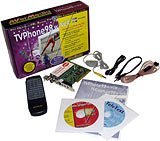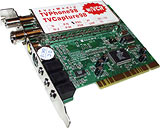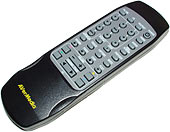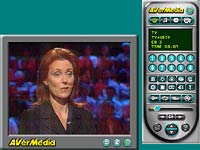
AverMedia TVPhone98 w/VCR
Review date: 10 October 2000. Last modified 03-Dec-2011.
Doing video on PCs used to be absolutely bloomin' excruciating.
Back in the dark days of 1994 or so, it was theoretically possible to make an IBM compatible that could at least capture video frames, and maybe show TV programs on the monitor.
And if you had the right motherboard and the right video card and the right drivers and enough patience to wrestle with bloomin' video card feature connectors and external pass-through cables and, I'm fairly sure, unfortunate rabbits, wiggly knives and black candles that came in sets of five, then you could make it all work.
But it was not worth the effort, for practically anyone.
Today, things have changed.
Modern PCs all have super-speedy CPUs. They all have a PCI bus, which gives extra video devices a quite well comprehended and implemented way of overlaying video on a screen without ghastly manual adjustments and strange compatibility issues.
Modern PCs have decent sound hardware with microphone and stereo line inputs and a stereo output, capable of better-than-CD-quality operation with no effect on system speed. And, importantly, most modern PCs run some version of Windows 98.
For all its sins, Windows has, finally, grown into a reasonably capable multimedia operating system. It's done it largely by throwing monstrously powerful hardware at the problem, but never mind.
What this means is that designers of PC consumer video gear don't have to worry too much about the hardware their products are going to run on, because all they need to do is hook into well-understood Windows features.
This is why every Windows webcam on the market's advertised as having "video phone" features. Get hold of Windows video-conferencing software, like Microsoft's own free NetMeeting package and plug in a camera and, if necessary, an extra five dollar microphone, and you'll be Max Headrooming away on your Internet videophone in no time.
So here's the AverMedia "TVPhone98 w/VCR", a TV and FM radio tuner and hard disk video recorder package, with auxiliary video inputs as well and a remote control. It sells for only $AU195. At the moment, in US dollars, I think that's about a nickel.
"VCR"?
If something that digitises video and saves it onto a computer's hard drive is a Video Cassette Recorder, then I suppose a Zip drive qualifies as a Punched Card Reader. But no matter. Consumer hard disk video recording systems are intended to do VCR-type tasks, with the added bonus of no tapes to fiddle with and random access - you can seek through a recording as quickly as you like.
To store lots of video, you need lots of disk space - but with hard disk space now costing about one Australian cent per megabyte, lots of disk space is something that the average consumer can easily acquire.
Raw, uncompressed video data is gigantic. 640 by 480, 24 bit, 25 frame per second video sucks down 23,040,000 bytes per second. Never mind capacity - most consumer hard drives can't even move data that fast!
Fortunately, modern compression systems greatly reduce this data load, and can easily stick an hour of VHS quality video on each gigabyte of drive space. This means a sub-$AU450 drive can record a whole day worth of programming. Drop the quality, get even more time.
The first of the true consumer digital "VCR" products was the TiVo, a stand-alone box (made by Sony or Philips) that operates as a largely automatic TV time-shifting system. It knows what's on and when, because it uses a built-in modem to snarf program listings in the dead of night.
The TiVo lets you record large amounts of what you're interested in, without you needing to know when the program's on - it takes care of that part. It also records live shows while you're watching them. This means you can press an "instant replay" button to move back in time, or pause live television - the TiVo just goes on recording, and you can watch what it's already recorded from any point, even as the TiVo adds more to the end of the recording. The further behind you are, the further you can spool forward at will - sayonara, ad breaks!
The TiVo can even make guesses about shows you might like to see, based on what you've told it about other shows with the simple "thumbs up" and "thumbs down" buttons. It records these "suggestions" of its own accord, when it's got nothing else to do.
TiVo's great. If you're in the USA, in one of the regions where it works. It doesn't work in Australia, and neither do any of the other TiVo-ish gadgets.
Here, we're stuck with more basic systems, like the TVPhone98. Forget integrated TV guides and cunning program-type analysis, and also forget stand-alone convenience. This is a PC expansion card, not a "blackgoods" product.
Then again, a TiVo has a list price of at least $US299, plus another $US199 for the service, or a monthly fee of $US9.95. They're running a $US100 off deal at the moment, but a board like the TVPhone still works out a lot simpler.
What you get
The TVPhone98 package gives you the card itself, the remote control, a couple of software CDs, a slim manual, a microphone, an FM antenna, an IR receiver cable for the remote, and a short audio lead so you can connect the TVPhone's audio out to your sound card's input.
The connectors on the back of the TVPhone98. From left to right, they're for the FM antenna, the TV antenna, composite and S-Video input, audio out and in, and the IR connection. There's no video output - the TVPhone's output goes to your monitor, not to a TV. If you've got a video card with TV output, though, you'll probably be able to use it as normal.
The remote receiver's just an IR sensor in a plastic mount. It comes with a Velcro dot that lets you mount it wherever's convenient. It's got decent range and viewing angle; anywhere a cheap remote-controlled TV would work, the TVPhone's remote ought to.
The FM antenna in the package is an ordinary cheapo dipole unit, as bundled with just about everything else in the world that can use an FM antenna. There's no TV antenna in the package.
The absence of a TV antenna is partly because there's no TV equivalent to the nearly-free FM dipole - even telescopic portable-TV "rabbit ears" cost a lot compared with a dipole - but it's mainly because not everybody who buys a TVPhone98 is going to need an extra TV antenna.
You can connect the TVPhone up to any 75 ohm coaxial TV signal cable - or to a 300 ohm ribbon cable, with a balun that'll cost you a few bucks from any electronics store.
This means you can use a plain indoor antenna, or an outdoor antenna, or a cable TV box with an "aerial" output. The TVPhone supports every TV standard and frequency in the world - including stereo sound, if it's available - so the system ought to work anywhere.
Use an indoor antenna near a PC and you'll often see some interference, at least on some channels. Even when it's enclosed in a metal case, a PC and its external cables commonly emit enough electro-magnetic radiation (EMR) to create noticeable noise.
EMR drops off with the square of the distance, so you don't have to move an indoor antenna very far from most PCs to get a better picture. But don't think an antenna sitting on top of your monitor's likely to give you a crystal-clear image.
Setting up
Installing the TVPhone is straightforward; it's just a PCI card. Windows detects it twice - the video and audio portions behave as separate devices - but apart from that the driver installation's easy, and well explained in the manual.
You only get Windows 95/98 drivers on the software disc, but there are Windows 2000 drivers and updated 95/98 ones available for free download from AverMedia here.
There's also out of date versions of NetMeeting and Internet Explorer on the main software disc, as well as an excitingly elderly version of DirectX, but you don't have to install any of this stuff, and DirectX installers won't let you install an older version over a newer one.
You also get a CD with Teletext software on it - well, with about one and a half megabytes of it, at any rate. If you're a power Teletext user, you'll probably love this software. Most people needn't even bother installing it, though.
The TVPhone98 supports closed captioning, as well, on programs that have it.
The Video E-Mail software on the main install disc wants a CD key to install; there isn't one anywhere in the box that I could find, and the paper manual doesn't even mention the e-mail software. It does mention an on-disc manual you're supposed to be able to access from the main software CD's default install menu, but there's no such option.
There's a "Product Information" link that takes you to a collection of unsightly HTML puff pages for other AverMedia products, but you have to find the HTML-format manuals yourself. They're in the "Document" directory on the main CD.
Once you find the on-disc documentation, though, it's all simple enough to follow.
The short 1/8th inch stereo pass-through lead connects the TVPhone's audio out and your sound card's line in, so the TVPhone's tuner sound will be accessible through the standard Windows volume control options.
That's how the TVPhone sets its volume - it just uses the standard Windows feature. You can just as easily connect the TVPhone audio out to anything else with a line in, using an appropriate adapter lead, in the same way as you can connect any PC's audio out to a TV or a hi-fi or whatever.
Do this, and the TVPhone's Mute button still works, but its volume control doesn't. You'll have to use the volume control on whatever alternative audio device you've used. But you won't get any computer sound overlaid on your TV audio, no matter how the computer's mixer settings are configured.
Once you've got the TVPhone installed, it's got an "autoscan" mode that'll sweep through the most likely TV channel frequencies and store whatever channels it finds.
The autoscan's likely to put channels on weird and wonderful numbers, and detect a few white-noise channels as well; it's easy to weed out the duds and remap the real ones to the right numbers.
You can also do an "all channel auto-scan" that goes in 1MHz increments from 54MHz to over 800MHz, and should therefore pick up every channel everywhere, regardless of what your local broadcast or cable channels are.
You can fine tune channels, and you can also lock them out, so your kids won't be able to sneak onto the computer and watch racy movies on SBS late at night. The lockout can be permanent, or set to only happen at particular times, and there is of course password protection that'll almost certainly stop any children under the age of eight.
Setting up the FM Radio mode works in the same way as configuring TV channels, except without the lock-out feature. There's a button on the remote to select FM mode, and another that lets you switch to audio CD playback mode as well, if you've got an audio disc in the computer's drive.
Using it
When the TVPhone's not doing anything, you can still use its remote - for cursor control.
The nine-key number pad moves the mouse pointer, with a couple of nearby keys doing left and right mouse button duty and the 5 key for locked-left-button click-and-drag purposes.
Press the power button on the remote, though, and the TVCapture98 software runs. Now the remote behaves like a remote. Channel changing, volume adjustment, record, play and stop, and so on.
The "VCR" function's simple enough. You press record, and it starts recording what you were watching. You press play, and it plays back whatever was recorded last; a simple file requestor lets you pick what recording to play.
You can also use the Scheduler application to set the TVPhone to record shows, like a normal VCR except with a better user interface. There's the usual periodicity options - daily, weekly, monthly - and separate quality settings for different recordings, and you can select the video source to use for each recording, and so on. There doesn't seem to be a limit to how many recordings you can set up, so you could easily harvest every soap opera on a channel for months on end, assuming you had enough disk space.
You've still only got an ordinary single-channel tuner, though, so you can never record two things that are on simultaneously.
Recordings are saved as AVI files, using MotionWavelets video codec from Aware, Inc. This isn't a free codec - you can't just download it - so if you want to view TVPhone recordings on another machine, that machine will need to have the TVPhone software installed too, or you'll need to use a movie file editing package to reprocess the video into a more common format.
You can pick a variety of recording resolutions and compression settings. Going with the weeny 192 by 144 resolution, a low frame rate and crummy audio quality will let you fit a ton of video into a small space, and is a useful for talking-head shows and similar radio-with-pictures television. At maximum quality, the TVPhone gives results about as good as those from an S-VHS VCR.
You can easily capture still images as well as video clips, but the image pauses for a moment when you hit the capture button. The software just dumps the images as numbered BMP files.
16-Channel Preview mode shows you up to 16 channels in a four-by-four matrix. The tuner isn't capable of receiving more than one channel at a time, so it just looks at each one for a moment (playing the sound, as well), then freeze-frames it and moves on to the next square and channel.
Overall
The documentation might be a bit hokey and the software bundle less than perfect, but the TVPhone98 system really does work. On any fairly recent PC, with just about any Windows-supported and fairly recent graphics and sound hardware, the TVPhone does what it's supposed to do as well as it can be expected to. It doesn't magically turn a crummy indoor antenna's output into a perfect picture, but that's not a feature you'll find on the spec sheet.
That said, though, this is not an utterly straightforward plug-and-go product. The big deal with the TiVo and its ilk is that they're about as simple to use as a gadget with all of their super features can be. The TVPhone and devices like it, though, aren't.
It's not their fault; it's because they hook into Windows to do their thing, and Windows itself is not kind to newbies.
For instance, Joe Average is not going to know, off the top of his well-scratched head, why it is that everything he records has a thin scratchy nothing for a soundtrack, while live TV and radio sounds fine. It took me a moment to remember about Windows' sound mixer settings - it has a separate set for recording, and Line In was disabled completely.
Volume Control -> Options -> Properties -> Recording -> OK, enable line in, yank its level up to the half-way mark, problem solved. The work of ten seconds. For does-this-stuff-for-a-living me.
An hour of frustration and phone calls and Web surfing, for someone who thought that a VCR should work like a VCR, not like the Marquis de Sade's own intelligence test.
Within these limitations, though, the TVPhone98 almost qualifies as elegant, and it's good value for money.
TVPhone98 w/VCR package kindly provided by AME Group






